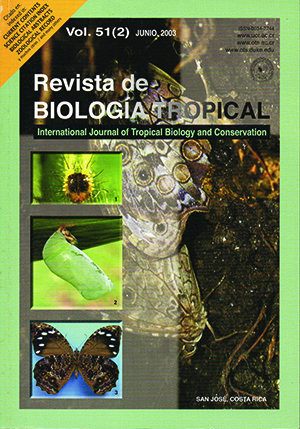Abstract
Observations about the floral biology and the reproductive system of Macroptilium fraternum were made in two populations in Argentina, with different edaphic conditions, situated at the southern area of distribution of the species. The coexistence of two kind of flowers in the same plant was detected in both populations and in herbarium material from other localities: a) cleistogamous preanthesis flowers and b) pseudocleistogamous flowers. The cleistogamous preanthesis flowers possesed wings longer than 5 mm and were disposed in pubescent, erect, racemes exposed above the level of the foliage. The anthesis lasted approximately 5 hours on sunny days or 9 hours on rainy days, the right wing covered the left wing, the corolla acquired a bilabiate aspect, offering the left wing as landing platform; they produced a low quantity of nectar (0.18 ± 0.13 μl); they did not receive pollinator visits; approximately four hours after the beginning of the anthesis on sunny days the ovary started to grow; in the bud, the receptive stigma was covered with germinating pollen grains from the same floral unit. The pseudocleistogamous flowers possesed wings shorter than 5 mm that were disposed in brief, hirsute and prostrate racemes, non subterranean as in other Macroptilium species; the banner started to spread exposing partially the wings, the left wing limb surrounded the keel and never spread; the right wing started to spread and after 2 seconds refolded and began to wither, the ovary began to grow immediately; the flower did not offer a surface to allow visitors to settle; in the buds the stigma was receptive and found with pollen grains from the same floral unit emiting their tubes. The relative reproductive success was low (natural pollination = 8%; spontaneous self-pollination = 3%), probably due to the low pollen viability, the high percentage of seed abortion and the lack of pollinator’s visits. The production of both flower types is not conditioned by edaphic factors, as they were found in plants belonging to different environments. Study of the progeny of both floral types in both populations has demonstrated that each one produces a similar amount of seeds contributing to the next generation with plants of similar characteristics (slow development, low resistance to infections and high mortality). The absence of pollinators in these flowers (in part because they preferred to visit flowers of other species with more reward and in part because of the fragmentation of the habitats), would be producing inbreeding depression in the studied populations; if the germplasm variability is not preserved, these populations situated at the Southern end of the distribution range of the species could become extinguished.
##plugins.facebook.comentarios##

This work is licensed under a Creative Commons Attribution 4.0 International License.
Copyright (c) 2003 Revista de Biología Tropical
Downloads
Download data is not yet available.


